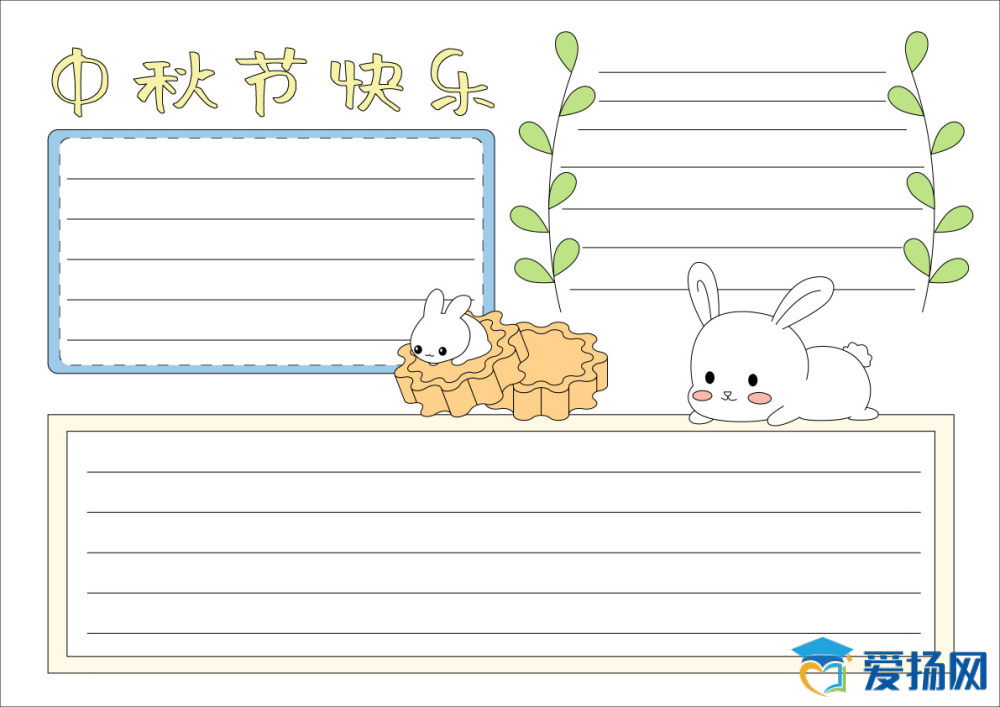猴年中秋節(jié)英語手抄報(bào)版面設(shè)計(jì)邊框圖案內(nèi)容2018
更新時(shí)間:2022-06-17 23:16:40 綜合手抄報(bào) 我要投稿
- 相關(guān)推薦
猴年中秋節(jié)英語手抄報(bào)版面設(shè)計(jì)邊框圖案內(nèi)容2018
猴年中秋節(jié)英語手抄報(bào)版面設(shè)計(jì)邊框圖案內(nèi)容2014
猴年中秋節(jié)英語手抄報(bào)版面設(shè)計(jì)邊框圖案內(nèi)容





Mid-Autumn Festival (also known as the Moon Festival), the third major festival of the Chinese calendar, is celebrated on the 15th day of the 8th month, as the moon is supposed to be at its maximum brightness for the entire year.
The moon definitely spins countless legends throughout the ages. Of course, the most famous legend is the one surrounding the "lady living in the moon" that dates back to ancient times, to a day when ten suns appeared at once in the sky. The Emperor ordered a famous archer to shoot down the nine extra suns. Once the task was accomplished, Goddess of Western Heaven rewarded the archer with a pill that would make him immortal. However, his wife found the pill, took it, and was banished to the moon as a result. Legend says that her beauty is greatest on the day of the festival.
Another legend depicts a possible role that the festival played in Chinese history. Overrun by the Mongols in the thirteenth century, the Chinese threw off their oppressors in 1368 AD. It is said that mooncakes - which the Mongols did not eat - were the perfect vehicle for hiding and passing along plans for the rebellion. Families were instructed not to eat the mooncakes until the day of the festival, which is when the rebellion took place.
The most lunatic mortal in Chinese history could have been the great poet Li Bai (701-762 AD), who once invited the moon to have a drink with him and his shadow to form a band of three. Li finally drowned in a lake in an effort to catch the moon when he was drunk one night.
The festive night can be one of the most charming and picturesque nights and the full moon is an auspicious symbol of abundance, harmony and luck. For thousands of years, the Chinese people have related the vicissitudes of life to changes of the moon as it waxes and wanes; joy and sorrow, parting and reunion. In Chinese culture, the family represents an important circle of relations that cannot be broken. Because the full moon is round and symbolizes reunion, the festival is also known as the festival of reunion. All family members try to get together on this special day. It is a happy occasion where people feast on scrumptious mooncakes. Some Chinese families today still stay up late to observe the occasion eating mooncakes, sipping tea and gazing at the beautiful moon. It is regarded the perfect moment if someone catches the moon's reflection in the center of his or her teacup. Those who can not return home watch the bright moonlight and feel deep longing for their loved ones.
【猴年中秋節(jié)英語手抄報(bào)版面設(shè)計(jì)邊框圖案內(nèi)容2018】相關(guān)文章:
2018猴年國慶節(jié)英語手抄報(bào)版面設(shè)計(jì)邊框圖案內(nèi)容06-17
猴年手抄報(bào)版面設(shè)計(jì)邊框圖案內(nèi)容06-18
2018猴年重陽節(jié)手抄報(bào)版面設(shè)計(jì)邊框圖案詩句內(nèi)容06-17
2018猴年感恩節(jié)手抄報(bào)版面設(shè)計(jì)邊框圖案內(nèi)容06-17
2018猴年新年英語手抄報(bào)版面設(shè)計(jì)邊框圖案資料06-18
2018英語暑假手抄報(bào)版面設(shè)計(jì)邊框圖案內(nèi)容06-17
2018快樂暑假英語手抄報(bào)版面設(shè)計(jì)邊框圖案內(nèi)容06-17
- 感恩節(jié)手抄報(bào)版面設(shè)計(jì)邊框圖案:感恩節(jié)是幾月幾日
- 國慶節(jié)手抄報(bào)邊框內(nèi)容花邊圖案
- 猴年感恩節(jié)手抄報(bào)版面設(shè)計(jì)邊框圖案內(nèi)容
- 學(xué)長征精神做紅色傳人手抄報(bào)素材
- 香港回歸的手抄報(bào)資料圖片
- 小學(xué)五年級愛眼護(hù)眼手抄報(bào)圖片簡單
- 小學(xué)生數(shù)學(xué)小報(bào)圖片
- 反欺凌防傷害手抄報(bào)花邊簡單又漂亮
- 澳門回歸手抄報(bào)圖片
- 學(xué)生感恩節(jié)手抄報(bào)版面設(shè)計(jì)邊框圖案小故事
- 黑板報(bào)版面設(shè)計(jì)
- 手抄報(bào)
- 綜合手抄報(bào)
- 元旦手抄報(bào)
- 環(huán)保手抄報(bào)
- 讀書手抄報(bào)
- 春節(jié)手抄報(bào)
- 學(xué)雷鋒手抄報(bào)
- 植樹節(jié)手抄報(bào)
- 教師節(jié)手抄報(bào)